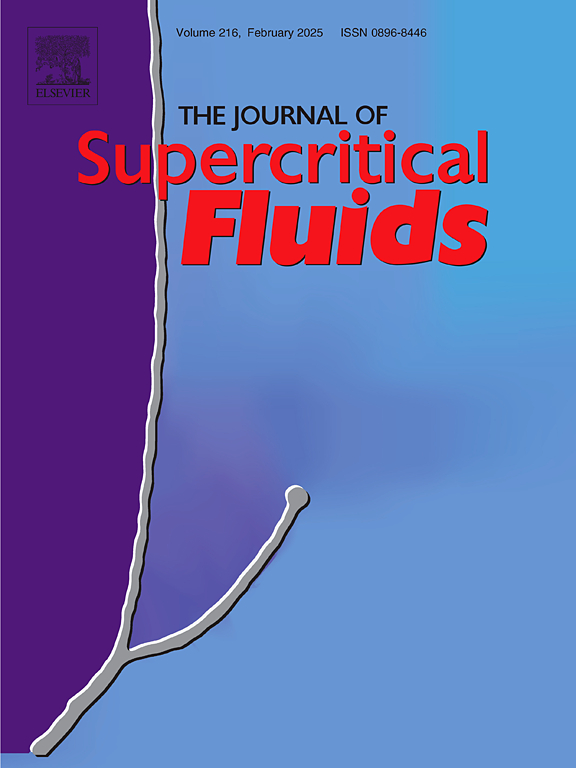Rapid extraction of xanthohumol, α- and β-acids from spent hops using pressurized liquids and supercritical fluids
IF 3.4
3区 工程技术
Q2 CHEMISTRY, PHYSICAL
引用次数: 0
Abstract
The recovery of bioactive compounds from spent hops from dry-hopping was obtained by pressurized liquid (PLE) and supercritical fluids (SFE) with cosolvent. PLE was performed at 10 MPa, with 50, 75, and 100 wt% ethanol in water at 70, 90, and 110 °C. SFE was performed using carbon dioxide with 10 wt% ethanol at 15, 25, and 35 MPa, and 40, 50, and 60 °C. The extracts were evaluated in terms of global yield, total reducing capacity (TRC), antioxidant capacity (ORAC), and content of target compounds. Temperature had little influence on the PLE results, except for α-acids, which were converted to iso-α-acids at 110 °C. The solvent composition impacted TRC, with 75 % ethanol being more efficient in extracting phenolic compounds (30.31 ± 2.86 mg GAE/g spent hops at 110 °C). The kinetics of PLE showed that most compounds are rapidly extracted in the first 6 min. In SFE, pressure was the most important factor, with 25 MPa and 60 °C being the most effective condition (36.21 ± 1.77 % global yield). Higher pressures and temperatures led to the co-extraction of undesired compounds, reducing α- and β-acid yields. The kinetics SFE curves exhibited a similar pattern to those of PLE, revealing that most compounds were quickly recovered in the first 6–7 min. Spent hops from dry-hopping are a promising source of xanthohumol and α- and β-acids, with high antioxidant capacity and potential applications in the food, cosmetic, and pharmaceutical industries.
利用加压液体和超临界流体快速提取酒花中黄腐酚、α-酸和β-酸
通过加压液体(PLE)和带有共溶剂的超临界流体(SFE)从干啤酒花中回收生物活性化合物。加压液化法在 10 兆帕的压力下进行,在 70、90 和 110 °C的温度下将 50、75 和 100 wt% 的乙醇加入水中。SFE 在 15、25 和 35 兆帕以及 40、50 和 60 °C条件下使用二氧化碳和 10 wt%的乙醇进行。对提取物的总产量、总还原能力(TRC)、抗氧化能力(ORAC)和目标化合物含量进行了评估。温度对 PLE 结果的影响很小,但对α-酸的影响除外,α-酸在 110 °C时转化为异-α-酸。溶剂成分对 TRC 有影响,75% 的乙醇萃取酚类化合物的效率更高(110 °C 时为 30.31 ± 2.86 mg GAE/g)。酚类萃取动力学表明,大多数化合物在最初的 6 分钟内被快速萃取。在 SFE 中,压力是最重要的因素,25 兆帕和 60 °C 是最有效的条件(总收率为 36.21 ± 1.77%)。更高的压力和温度会导致不需要的化合物的共萃取,从而降低α-和β-酸的产量。SFE 的动力学曲线与 PLE 相似,表明大多数化合物在最初的 6-7 分钟内迅速回收。干啤酒花是黄腐醇、α-和β-酸的重要来源,具有很高的抗氧化能力,有望应用于食品、化妆品和制药行业。
本文章由计算机程序翻译,如有差异,请以英文原文为准。
求助全文
约1分钟内获得全文
求助全文
来源期刊

Journal of Supercritical Fluids
工程技术-工程:化工
CiteScore
7.60
自引率
10.30%
发文量
236
审稿时长
56 days
期刊介绍:
The Journal of Supercritical Fluids is an international journal devoted to the fundamental and applied aspects of supercritical fluids and processes. Its aim is to provide a focused platform for academic and industrial researchers to report their findings and to have ready access to the advances in this rapidly growing field. Its coverage is multidisciplinary and includes both basic and applied topics.
Thermodynamics and phase equilibria, reaction kinetics and rate processes, thermal and transport properties, and all topics related to processing such as separations (extraction, fractionation, purification, chromatography) nucleation and impregnation are within the scope. Accounts of specific engineering applications such as those encountered in food, fuel, natural products, minerals, pharmaceuticals and polymer industries are included. Topics related to high pressure equipment design, analytical techniques, sensors, and process control methodologies are also within the scope of the journal.
 求助内容:
求助内容: 应助结果提醒方式:
应助结果提醒方式:


